Disc pads - inspection and renewal
Caution: Refer to the precautions in Section 1.
Front disc pads
1 The disc pad friction material can be
inspected for wear without removing the
roadwheels. Working beneath the vehicle,
insert a mirror between the caliper and the
roadwheel and check that the friction material
thickness is not less than the minimum given
in the Specifications.
2 If any one of the pads has worn below the specified limit, the front pads must be renewed as an axle set (4 pads).
3 To renew the pads, slacken the front roadwheel nuts, apply the handbrake, then jack up the front of the vehicle and support on axle stands (see “Jacking and Vehicle Support”). Remove the roadwheels. On P100 models, mark the position of the roadwheels in relation to the wheel studs before removal.
4 Proceed as follows according to model:
Girling caliper (1.3 and early 1.6 litre
models)
5 Where applicable, disconnect the wiring to
the disc pad wear sensor.
6 Unscrew and remove the bolt from the upper caliper guide pin while holding the pin stationary with a spanner (see illustration).
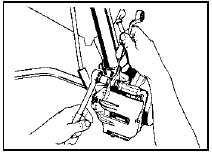
4.6 Unscrewing the bolt from the upper caliper guide pin - Girling caliper
7 Swing the caliper downwards and lift out the disc pads. If the outboard pad is stuck to the caliper, free it using a screwdriver with the guide pin bolt fitted, as shown (see illustration).
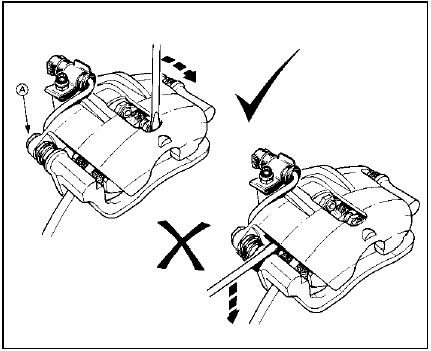
4.7 Correct and incorrect methods of freeing stuck outboard disc pad. Guide
pin bolt (A) must be in position - Girling caliper
Do not use a screwdriver to free the inboard pad, as this may damage the piston dust seal. The inboard pad can be freed by hand after lowering the caliper.
8 Brush all dust and dirt from the caliper, pads and disc, but do not inhale it as it may be injurious to health. Scrape any corrosion from the disc.
9 As the new pads will be thicker than the old ones, the piston must be pushed squarely into its bore to accommodate the new thicker pads. Depressing the piston will cause the fluid level in the reservoir to rise so to avoid spillage, syphon out some fluid using an old hydrometer or a teat pipette. Do not lever between the piston and disc to depress the piston ideally a spreader tool, applying equal force to both sides of the caliper, should be used (see illustration).
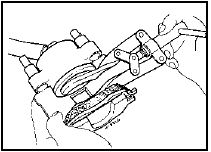
4.9 Using a spreader tool to depress the caliper piston into its bore
10 Further refitting is a reversal of removal bearing in mind the following points.
11 If disc pads with wear sensors are fitted, the pad with the sensor wire should be fitted inboard.
12 Ensure that the anti-rattle clips are correctly located on the caliper.
13 Repeat the procedure on the opposite front brake.
14 On completion, apply the footbrake hard several times to settle the pads, then check and if necessary top-up the fluid level in the reservoir.
15 Avoid heavy braking, if possible, for the first hundred miles or so after fitting new pads. This will allow the pads to bed in and reach full efficiency.
Teves caliper (Later 1.6, 1.8 and 2.0
litre models)
16 Prise the retaining clip from the caliper.
Hold it with a pair of pliers to avoid it causing personal injury.
17 Unclip the pad wear sensor from the caliper, and disconnect the wiring plug (see illustration).
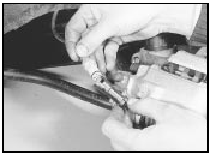
4.17 Disconnect the pad wear sensor wiring plug - Teves caliper
18 Using a 7 mm Allen key, unscrew and remove the two guide bolts securing the caliper to the carrier bracket, and withdraw the caliper (see illustration). Support the caliper on an axle stand to avoid straining the hydraulic hose.
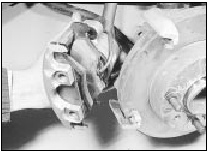
4.18 Withdrawing a caliper from its carrier bracket - Teves caliper
19 Withdraw the disc pads from the caliper (see illustration).
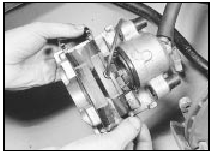
4.19 Withdraw the disc pads from the caliper - Teves caliper
It may be necessary to prise the outboard pad with a screwdriver to release it from the caliper. Do not use a screwdriver to free the inboard pad, as this may damage the piston dust seal.
20 Proceed as described in paragraphs 8 to 15 inclusive, but in addition ensure that the clip on the back of the inboard pad fits into the piston recess (see illustration),

4.20a The clip on the back of the inboard disc pad fits into the piston
recess - Teves caliper
refit the
caliper retaining clip, and ignore the reference
to the anti-rattle clips (see illustration).
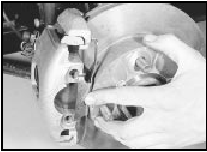
4.20b Refitting the caliper retaining clip - Teves caliper
On P100 models align the previously made marks on the roadwheels and wheel studs.
Late model modification
21 On some later models, slightly revised
front brake components are used. A new type
of retaining clip is used to secure the pads in
the caliper, and the caliper body is modified
accordingly. Also, plastic covers are fitted to
the caliper guide bolts (see illustrations).
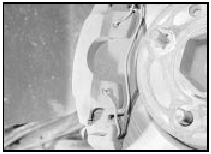
4.21a Later type front disc pad retaining clip
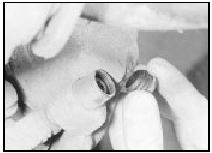
4.21b Removing a caliper guide bolt cover - later type
22 Procedures are unchanged from those given above.
Rear disc pads
23 Slacken the rear roadwheel nuts, chock
the front wheels, then jack up the rear of the
vehicle and support on axle stands. (see
“Jacking and Vehicle Support”). Remove the
roadwheel.
24 The disc pads can be inspected through the top of the caliper after removal of the blanking spring clip. Check that the friction material thickness is not less than the minimum given in the Specifications.
25 If any one of the pads has worn below the specified limit, the rear pads must be renewed as an axle set (4 pads).
26 To renew the pads, proceed as follows.
27 Release the handbrake, and free the handbrake cable from the suspension lower arm by bending back the tangs.
28 Where applicable, disconnect the wiring to the disc pad wear sensor (see illustration).
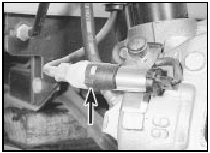
4.28 Rear disc pad wear sensor wiring clip (arrowed)
29 Unscrew and remove the bolt from the forward caliper guide pin, while holding the pin stationary with a spanner (see illustration).
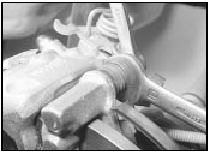
4.29 Unscrewing the forward caliper guide pin bolt
30 Swing the caliper rearwards and lift out the disc pads (see illustration). Do not depress the brake pedal with the caliper removed.
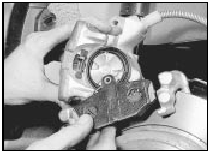
4.30 Lift out the disc pads
31 Brush all dirt and dust from the caliper, pads and disc, but do not inhale it as it may be injurious to health. Scrape any corrosion from the disc.
32 As the new pads will be thicker than the old ones, the piston must be retracted into its bore to accommodate the new thicker pads.
Retracting the piston will cause the fluid level in the reservoir to rise, so to avoid spillage, syphon out some fluid using an old hydrometer or a teat pipette. Retract the caliper piston by turning it clockwise. Ford tool No 12-006 is designed for this purpose, but a pair of circlip pliers or any similar tool can be used instead (see illustration).
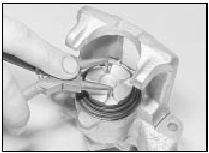
4.32 Retracting the piston using circlip pliers
33 Remove the backing paper from the new pads, and fit them to the caliper.
34 Further refitting is a reversal of removal, bearing in mind the following points.
35 If disc pads with wear sensors are fitted, the pad with the sensor wire should be fitted inboard.
36 Repeat the procedure on the opposite rear brake.
37 On completion, switch on the ignition and apply the footbrake hard several times to settle the pads. Switch off the ignition, then check and if necessary top-up the fluid level in the reservoir. Check the operation of the handbrake.
38 Avoid heavy braking, if possible, for the first hundred miles or so after fitting new pads. This will allow the pads to bed in and reach full efficiency.
See also:
Jump starting your vehicle
The gases around the battery can explode if exposed to flames,
sparks, or lit cigarettes. An explosion could result in injury or
vehicle damage.
Batteries contain sulfuric acid which can burn ski ...
Instrument Cluster
Warning lights and chimes
Warning lights and gauges can alert you to a vehicle condition that may
become serious enough to cause expensive repairs. A warning light may
illuminate when a problem ...
Engine idle speed check (Every 6000 miles (10 000 km) or 6 months)
Caution: Refer to the
precautions in Section 1,
Chapter 4, Part A or B (as
applicable), before proceeding.
Before carrying out any carburettor
adjustments, ensure that the ignition
timing and sp ...
